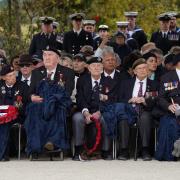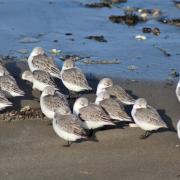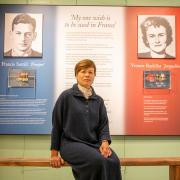Never one to be hampered by self doubt, Patrick Gibbs is an artist who makes his own rules as our art expert Sandra Smith found out

“I remember very clearly what I thought as a seven year old when I saw people catching the train to work: why would anyone do that? I wanted to do something I loved: to have the freedom to be a painter. Even as a teenager I didn’t conform. Actually I was quite cocky, so I may have been disappointed at failing my Art O Level - but I was also quite proud! I knew I deserved to pass.”
Now, I profess there’s nothing I admire more than a smattering of rebellion. So while, on the one hand, I am keen to explore the evolution of Patrick Gibbs’ career and his artistic calling, I am also sidetracked by such a slap in the face to authority. In fact, it’s an outlook, I’m pleased to report, that resurfaces once or twice during our time together.
For instance, from an early age Patrick’s trust in his abilities was matched by a compelling determination to succeed. But there were obstacles: his skills and style did not comply with the academic criteria to which his tutors aspired. “At school they wanted me to do tight, neatly drawn still life but I was drawn to more lively stuff than that. Even when I went to Oxford University there was no nurturing. Abstract painting was not something that interested me yet tutors weren’t capable of figurative work so they just pushed me in the direction in which they had been pushed. I also think they wanted to bring us down a notch or two.”
I can’t imagine anyone succeeding in diminishing Patrick’s belief in himself. Not that he is remotely arrogant. In fact, I wouldn’t even describe him as cocky. What he does possess in abundance, however, is an unshakeable confidence in his innate talents - a characteristic as un-British-like as it is bracing. Hardly surprising, then, that such self assurance has been a major factor in his success.
Still, when he left university, conscious >> of the improbability of making a living out of painting, he was initially at a loss how to pursue his career. Travel seemed like a reasonable alternative and when a friend invited him to Germany he deliberately took a break from the arts in order to reassess his ambitions. “I intended staying a few weeks,” Patrick recalls, “but ended up living there for a year doing lots of jobs including working on building sites, driving vans and teaching English. When I started painting again I spent a couple of months in Edinburgh producing street portraits. After that I went to Devon and taught myself landscapes, then moved to Italy to carry on practising my painting.” During this period of discovery Patrick supported himself financially via street portrait work as well as selling landscapes.
Finally, during his mid twenties, and with the foundations of technique established, Patrick returned to England. Here he linked up with a university friend and together they held a couple of exhibitions.
“In the first show,” Patrick explains, “I sold about half of my paintings that were on display. I may have been pleased but the gallery’s disappointment shocked me. Then it dawned on me that they were primarily motivated by money. I’d been so naive. Up to then I’d worked out my prices by asking various people how much they thought my pieces were worth and taking an average. But now the gallery determined the price and I realised I’d been selling paintings at half of what they should have gone for.”
His frustration at the lack of business acumen taught in art school is palpable. Indeed, he adds, it was only thanks to a more experienced artist that he eventually gained practical tips including the valuation of art, dealing with galleries and the importance of mailing lists. Such commercial nous has since enabled Patrick to develop a thriving career though the memory of his first sale is vivid. “I painted a watercolour nude at university and a tutor offered me £10 for it. I thought it was a fortune!”
Turning to his current work, what about those subjects which stimulate him now? I’m intrigued that places like Zanzibar, Burma and Cuba are where he finds inspiration. “I love going to countries which are not as advanced as we are,” he clarifies, “where locals do traditional every day things that they regard as normal. There’s something about their simple lives which is special, nostalgic. People always have smiles on their faces while we over complicate our lives.” So is he tempted to swap his western existence for such simplicity? “I’m happy because I’ve seen the light. I frequently visit these countries and enjoy them.”
Much of his art certainly reflects the many, basic tasks which people carry out on a daily basis. Not that his paintings exude pity, nor even demand compassion. On the contrary, they are colourful representations of other cultures, informing the onlooker while at the same time offering an insight into priorities of the country’s inhabitants.
But this is an artist unencumbered by the limits of any one theme. British landscapes, nudes, architecture and even Wimbledon are all worthy subjects for Patrick who lists Caravaggio, Vermeer and Monet as some of the artists by whom he is most influenced.
After a period of working with acrylics, these days he predominantly concentrates on oils, a change of medium which initially involved a measure of re-learning to accommodate textures and methods. As he often works on up to 20 pieces at any one time, there is the option to leave a painting to dry for several days before returning to add more layers. On average each canvas takes up to two months from start to finish and Patrick completes around 50 paintings every year.
As this ambitious artist continues to strive towards his challenges of self improvement and originality, he confesses that his career has been, “much harder work than I’d imagined,” yet creative independence and energy remain key motivators.
Even so, and typical of many in the creative professions, satisfaction is a rare achievement. He does, nevertheless, recognise one of the most pleasing aspects of his work: “I am happy when someone has bought a painting and they are excited. You can see it in their faces.”
Patrick is hoping to witness such delight at Winchester’s Minster Gallery which is hosting his Travels exhibition until December 9 thereby bringing to Hampshire a taste of the lives of people from distant lands. He appreciates that one of the criteria of a successful show, and one which makes him proud, is presentation and good surroundings, standards to which this Gallery adheres. “The sun, the heat and the atmosphere of the wonderful places to which Patrick has travelled will fill The Minster Gallery,” owner Ines Graham reveals, adding, “the result is a collection of work of outstanding quality and variety: an exhibition not to be missed.”
For an artist so intent on doing things his way, a solo exhibition such as this is quite a nod to the establishment. Patrick Gibbs may have ticked all the right scholastic boxes, but he has simultaneously created his own style, his own career path and, most importantly, his own rules.
To find out more about Patrick and his upcoming exhibition visit: www.patrickgibbs.com and www.minstergallery.com



























